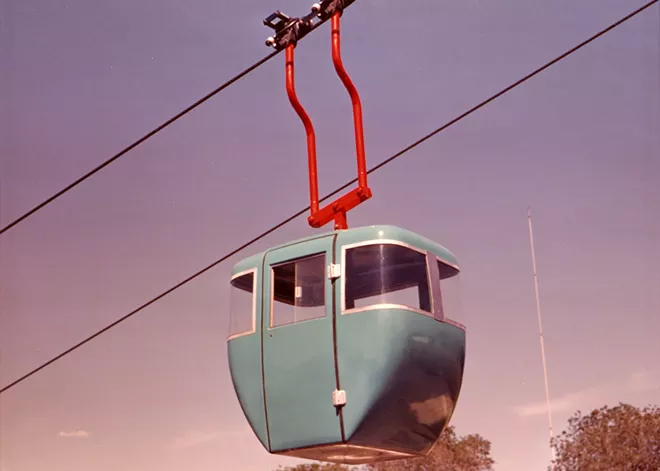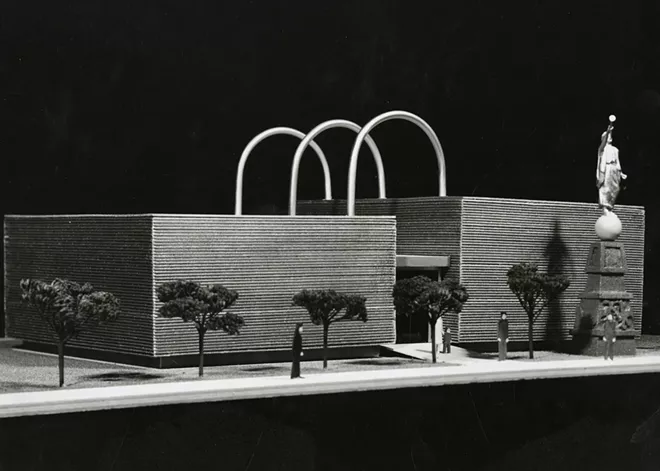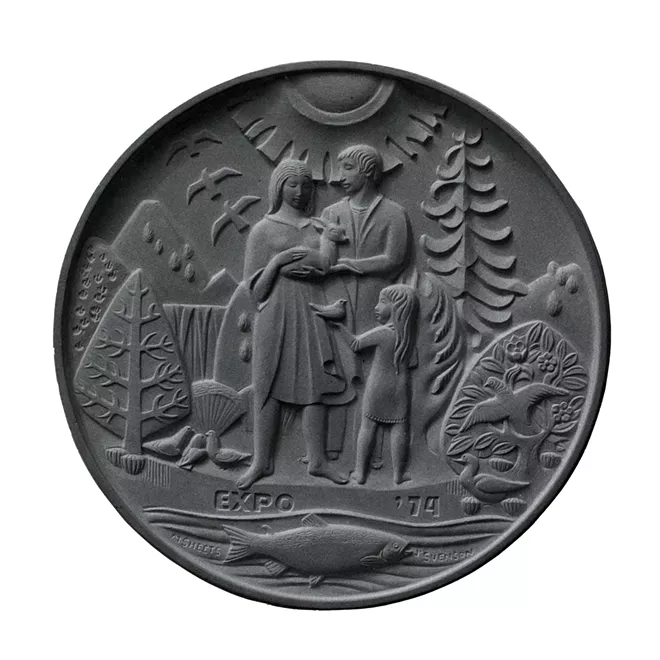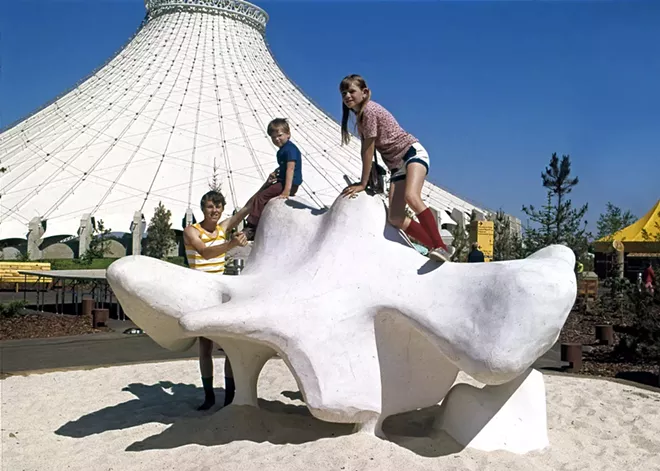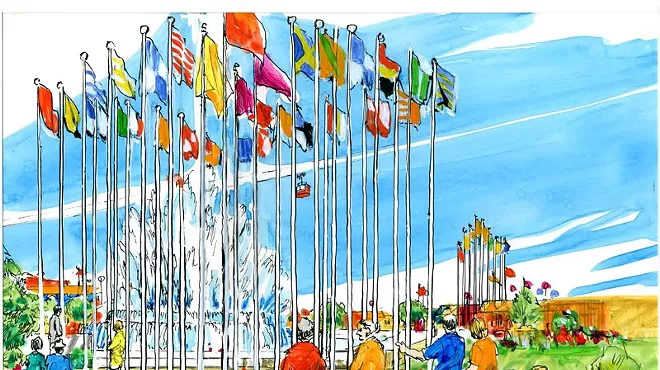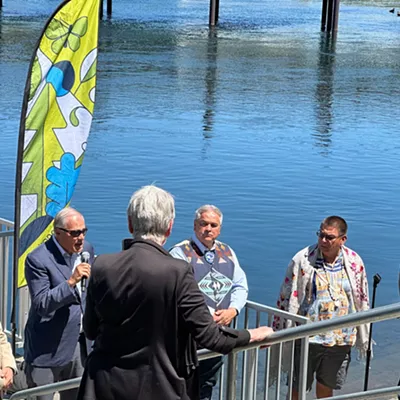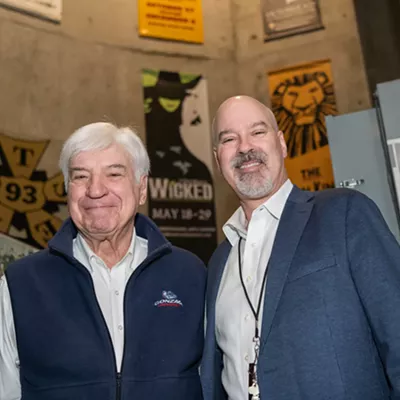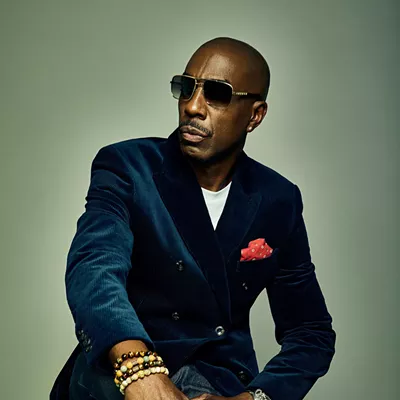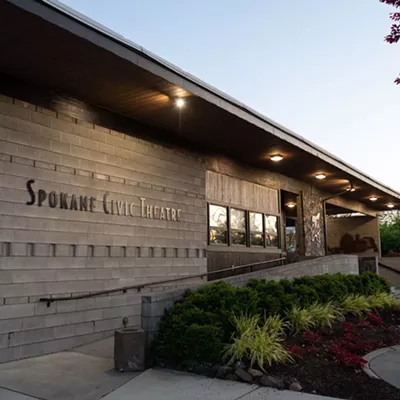FLYING OVER THE FAIR
There were three ways to get a view from above Expo '74. First, to experience the power of the Spokane Falls you could cross two brand-new suspension bridges over the the wildest parts of the river. Those spans continue to serve as a pedestrian connection — and a bit of a thrill ride during the highest spring runoffs, when you can feel the spray.
Then there were options for getting your feet off the ground. The A&W Sky Float (clever corporate tie-in!) was a double chairlift that moved you across the park and over the south channel of the Spokane River. Another beloved feature was the Skyride — a gondola that took visitors down into the spectacular Spokane River Gorge. Lucky for Spokane, a world leader in the ski lift industry was located right in town. RIBLET TRAMWAY built both the Sky Float and the Skyride attractions.
Riblet was established in 1896 by Byron Riblet, who was jack of all engineering trades. On one project, he helped solve a problem for a silver mine outside of Nelson, B.C., by installing a tram to move ore across rugged terrain. Fast forward four or five decades, and Riblet was building chairlifts out of its Spokane headquarters as fast as they could for the growing sport of skiing. By 2003, there were more than 500 resorts in North America with Riblets. The family history is alive in the Arbor Crest Cliff House, the mansion Byron's younger brother Royal built that looms high above Spokane Valley. Riblet Tramway closed up for good in 2003.
After the fair closed in November, the Sky Float was quickly dismantled; some of the lift equipment went to Schweitzer, the rest to Vail. After nearly 30 years of service, the Riblet gondolas were replaced in 2003 by a new set of European Doppelmayrs. You can still see some of the old gondolas around town, including in the lobby of No-Li Brewhouse.
MARCHING IN
Several religious groups were on hand for Expo '74, including the Moody Bible Institute and Seventh Day Adventists. But one religion went big: The Church of Jesus Christ of Latter-day Saints — aka the Mormons. Sitting on pilings out over the south channel of the Spokane River, THE MORMON PAVILION was built as a replica of the golden tablets the Book of Mormon was said to have been translated from. Volunteers staffed the pavilion throughout the fair, and the Mormon Tabernacle Choir even appeared for two shows on July 18-19.
The Mormon Church traces its history in the Inland Northwest to 1947. In 1974, the Spokane Washington Temple had four stakes; today that has quadrupled to 16 spread across Eastern Washington, North Idaho and northwestern Montana.
MYSTERY MEDALLION
The Northwest Museum of Arts and Culture has plenty of oddities and mysterious relics in its Expo Collection. One is of a cast medallion that was perhaps entered in the competition to be the commemorative medallion of the world's fair. If you look closely at the beautiful image of a young family in nature, with wildlife and even a salmon, it has the names "M. Sheets" and "J. Svenson" on it. MILLARD SHEETS AND JOHN EDWARD SVENSON were, in fact, a working art team; both served in World War II and studied at the Scripps colleges in California's Pomona Valley.
You can see Svenson's public art sculptures all over Southern California; this image for Expo is evocative of his "Ranchero" wood panel sculpture that still sits at the Millard Sheets Art Center in Los Angeles. Sheets created the "Touchdown Jesus" mural at the University of Notre Dame and the iconic facade of the Hilton Hawaiian Village on Waikiki Beach. The medallion that was sold at Expo (and that you can find in some vintage shops) was designed by George Tsutakawa, the beloved Seattle artist and brother of Ed Tsutakawa, who helped bring the Japanese Garden that now bears his name to Spokane. Like the fair, the Japanese Garden opened in May of 1974.
FRENCH CONNECTION
Expo '74 brought a lot of great flavors to Spokane. There was a Bavarian bier and brats hall, authentic Russian and Slavic food and a real French restaurant run by an actual native of Tours, France. Located on the Spokane River overlooking the clock tower. Frenchman Pierre Parker's dad was killed in World War II, and he relocated to California with his mom, who taught him to cook. He ran a restaurant in Laguna Beach and was then somehow bitten by the world's fair bug.
Dorothy Powers documented his journey in a January 1974 article for the Spokesman-Review: He ran French restaurants at the Seattle World's Fair in 1962; at New York's in 1964; at Montreal in '67; and at the HemisFair in San Antonio in 1968. In Spokane, he opened PIERRE'S INTERLUDE.
His secret? "Since everything is cooked only with butter, wine and cheese, all dishes are good," he told Powers.
One night during Expo, as related in The Fair and the Falls, King Cole and his wife, Jan, were walking back from a show, all dressed up, passing Pierre's Interlude.
"The fairgrounds were closed," Cole recalled. "It was a beautiful moon that night, warm." Pierre came out and said, "Come here, I want to give you something."
He guided them to a table by the water, disappeared for a bit and returned — with two French desserts. "Now just sit..." Parker told the man who had not stopped running, year after year, to transform the very landscape he could now marvel at.
"And relax."
— TED S. McGREGOR JR.
TURN THAT FROWN UPSIDE DOWN!
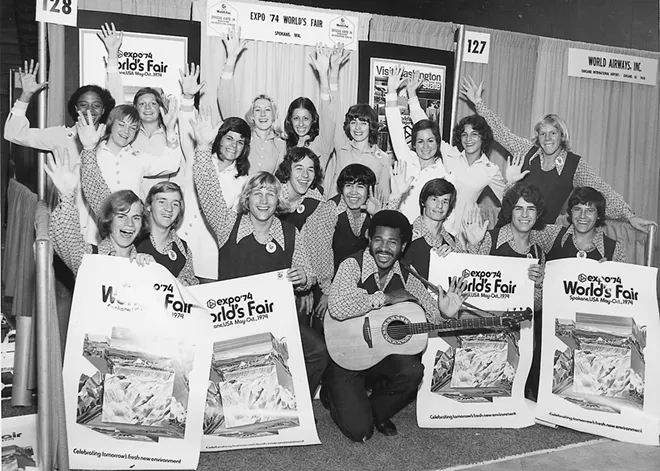
Mention UP WITH PEOPLE and those of a certain era may immediately begin singing the group's ear-worm of a theme song: "Up, up with people! You meet 'em wherever you go!"
A cast of the squeaky clean and relentlessly cheerful touring group was in residence at Expo '74 from May to October, sponsored by General Electric. A promotional video, preserved on YouTube, shows the cast dancing and singing its way across the fairgrounds. The women sashay in hot pink baby doll dresses (complete with suntan pantyhose), while the dudes frolic in maroon polyester pants with matching vests. (To see it for yourself, search YouTube for "Up with People Expo Spokane.")
Reacting to a show preview in March 1974, Spokane Daily Chronicle writer Harriet J. Connor was impressed. "The show is bright, light and full of plenty of zing and zap."
Up with People casts went on to perform in 771 cities in all 50 states on their Bicentennial Tour from September 1975 to July 1976. Super Bowl halftime shows have featured Up with People five times. Those appearances were parodied on The Simpsons when, to Homer's delight, "Hooray for Everything" performs a halftime "salute to the greatest hemisphere on earth: The Western Hemisphere! The dancingest hemisphere of all!"
Nearly 60 years after it was founded, Up with People is still around — and still cheerful — as they state on LinkedIn: "Intentional community, creativity & the arts, and determined optimism are at the heart of UWP. Young people can do incredible things when we act together, get creative and remain unapologetically hopeful."
— ANNE McGREGOR
LIVING HISTORY
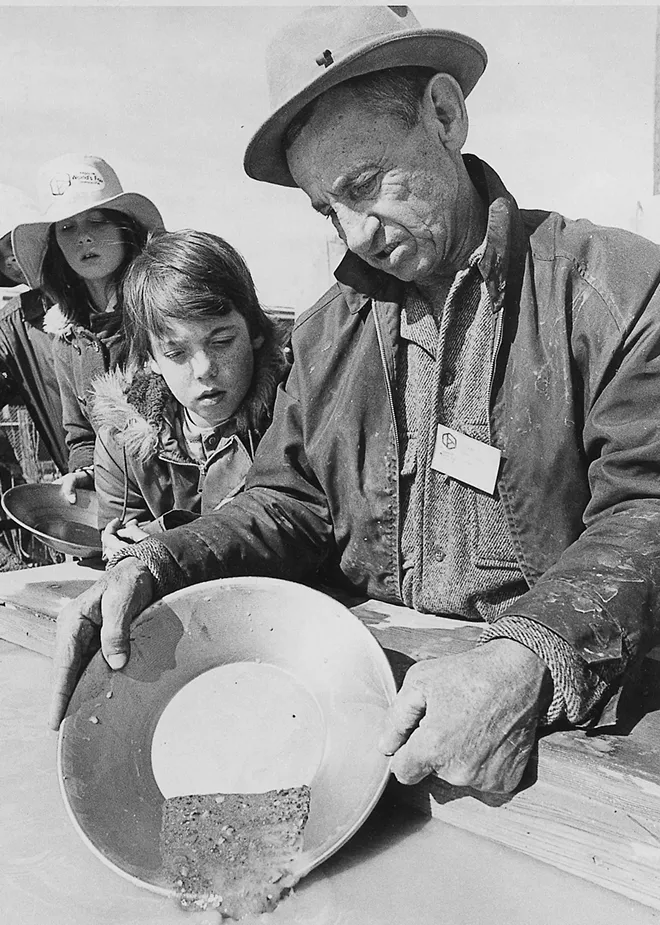
Next door to Native American’s Earth, visitors could connect with other facets of living Pacific Northwest culture and history. Loosely affiliated with the Smithsonian Institution, the FOLKLIFE FESTIVAL was a massive project to track down examples of regional folklife that could be transported to the fair. Manhattan-based art teacher and filmmaker Bob Glatzer took the job to lead the effort. Upon arriving, he immersed himself in the setting, moving into a house on the Spokane River in Peaceful Valley.
“We had about 30 groups in all,” Glatzer told the Inlander in 1999. “Basques from Boise, the Doukhobors [from British Columbia] and a group of Russian Old Believers from Oregon. We were an odd appendage to the world’s fair. Nobody in the Expo Corporation had any idea what we we did or why we were there. All they knew was that we were a great draw. It changed every day, sometimes every hour.”
Glatzer never left Spokane and became a mainstay of the local arts scene until his death in 2010.
BASKET CASE
Just a few days before Expo '74's opening ceremonies, another lasting local landmark made its debut when NORDSTROM SPOKANE and RIVER PARK SQUARE shopping mall both opened their doors to the public on May 1, 1974.
One of the items sold at Nordstrom Spokane in those early days was this folk art-inspired wooden basket purse by the popular Caro Nan brand, featuring colorful row house-style buildings with Spokane, Expo and Northwest-centric signage hand painted on it. Decoupage strips of international travel destinations and other collaged paper cutouts on the lid — along with a penny minted in 1973, for good luck and to show the year the basket was created — evoke the allure of travel.
Caro Nan's sturdy purses were the creative output of two Jackson, Mississippi-based best friends, Carolyn McDaniel and Nancy Steele — the company's name combines their first names. They became coveted accessories after launching in the mid-1960s. For each city the purses were made for, artists (the company employed women who hand painted the baskets in their homes) customized the building's storefront signs to evoke a sense of place. Likewise, the name of the store where these region-specific baskets were sold was painted on the inside lid.
This particular Caro Nan purse designed for Spokane and Expo was not only sold at Nordstrom Spokane sometime after its 1974 debut, but it was originally owned by Norma Lindsay, wife of Expo '74 Chairman Rod Lindsay.
— CHEY SCOTT
EXPO'S FRIENDLY FOSSIL
"There are not many artifacts of Expo left," a local man told the Spokesman-Review back in 2014. "We want to make sure they stay around. To me, the DINOSAUR BONE should be on the list to consider."
Expo brought in a ton of renowned artists to help create a fresh, new environment around downtown Spokane and the fairgrounds. One was Charles W. Smith, who created a sculpture for the world's fair that became known as the Dinosaur Bone. Smith was a fine artist and also founded the industrial design program at the University of Washington, where he taught for more than 40 years.
Kids — including me as a 9-year-old — loved to play on the Bone. You could slip down its sides, jump off it — epic kid stuff. But in the years after Expo, some grown-ups got to feeling that it was too dangerous. Some serious injuries were reported. In 2011, it was removed from the playground outside the YMCA (before that building was torn down to create more parkland) and banished to a Parks & Recreation storage yard.
Fast-forward to 2014, and Spokane voted to spend $64 million to renovate Riverfront Park, the public space left behind by the world's fair effort. I volunteered as the chairman of the Park Board's Riverfront Park Committee, and I was that local man getting grilled by the Review's reporter.
A lot of impressive work was done by some of the best in the business to get our park back up to snuff, and one of those firms was the Berger Partnership, which was responsible for the landscape design of the award-winning renovation. Guy Michaelson was the lead landscape architect — and a fan of the Dinosaur Bone. I'm not sure how, but without much fanfare Michaelson managed to free it from captivity. It just appeared near the new Ice Age Floods Playground around the time it opened on the north bank in 2021. As it should be: an original feature of the fairgrounds, back where it belongs.
— TED S. McGREGOR JR.
THE COSMIC JUMPER

Expo '74 was the subject of an actual U.S. Postal Service stamp — then just 10¢. Even better, PETER MAX did the artwork. Max was born in Berlin in 1937, but his Jewish family fled the Nazis and settled in Brooklyn. In the years since, he's done album covers, a mural on a chunk of the Berlin Wall and even painted the hull of a cruise ship. His character "Cosmic Jumper" is the subject of the Expo stamp; The New York Times wrote that, Max's "DayGlo-inflected posters became wallpaper for the turn on, tune in, drop out generation."
— TED S. McGREGOR JR.

